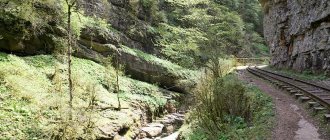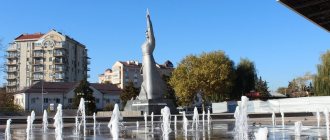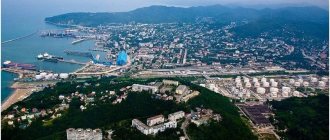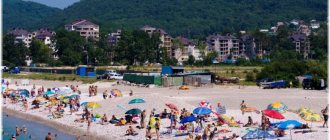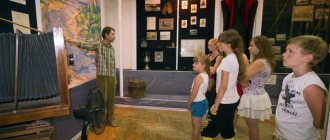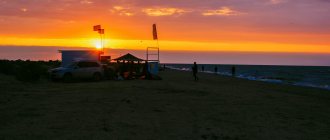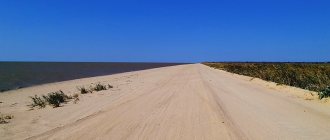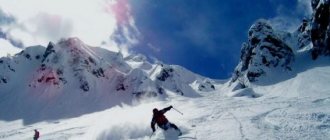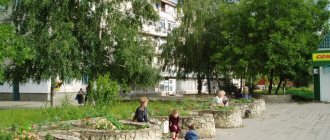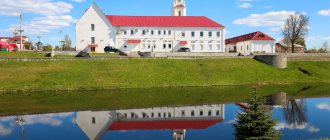Memorial complex Malaya Zemlya
Small Earth.
Monument to “Our Heroes” / photo from wikipedia.org Where is it located
Novorossiysk, Admiral Serebryakov embankment.
Why is this interesting?
A visit to this memorial complex is a tribute to the feat of Soviet soldiers during the Great Patriotic War.
The memorial was created on the site of the bridgehead, the defense of which lasted 225 days. Here in 1943 the operation to liberate the city began.
To defend this small piece of land, 70 thousand Soviet soldiers were sent here. The exact number of deaths is still unknown.
The central object of the complex is a memorial in the shape of the bow of a ship.
Its halves meet at a height of 22 m above the ground. There is a museum inside.
An alley of 225 poplars leads to the memorial, one for each day of defense.
On the ground around the memorial there are traces of trenches and trenches.
Despite the large number of visitors, it is always quiet and peaceful here. On the other side of the bay you can see the city. The panorama of the city looks especially attractive after sunset, when the lights come on.
How to get there
The memorial and other historical attractions of the Krasnodar Territory can be reached by public transport, the nearest stop is “Malaya Zemlya”. It is reached by buses No. 1 and 41m, trolleybus No. 7, minibuses No. 7, 10, 21, 22, 27, 28, 31, 38.
In the footsteps of passing centuries
The architectural monuments of Krasnodar are not just certain buildings that have a certain cultural and aesthetic value, but also one of the faces of this settlement, which is revealed to those who know how to see and read between the lines. There are many buildings of various types that were built in the 19th and early 20th centuries. They survived the revolution and German occupation, the difficult years of the formation and development of the USSR. There are also many interesting buildings from the Soviet period. Each era makes its mark in the form of buildings and monuments.
Russian Gate - a monument of Ottoman architecture
Russian Gate in Anapa
Where is it located?
In the southern part of Anapa, on the territory of the 30th Anniversary of Victory Park.
Why is this interesting?
These gates became Russian only in 1828, when Anapa was liberated from the Ottoman yoke.
This is all that remains of the fortress, built in 1783. The fortress was the main stronghold of the Ottoman Empire in the North Caucasus. The slave market operated here, and military operations to capture cities were controlled from here.
Russian troops sought to destroy the fortress, but it was not easy to break through the numerous fortifications. In 1791, Anapa fell, which forced the Turkish side to conclude a peace treaty. Under the terms of this treaty, Crimea was ceded to Russia, and Anapa remained part of the Ottoman Empire.
With their aggressive foreign policy, the Turks repeatedly violated the terms of the treaty. This led to Russia declaring war on the Ottoman Empire in 1827. In 1828, the Russian army took the fortress and the city. Since 1829, Anapa became part of Russia.
On the territory of the Russian Gate there are many monuments dedicated to the events of those years. The fortress gates themselves received the status of a monument of Ottoman military architecture.
How to get there
The path through the territory of the 30th Anniversary of Victory Park to the Russian Gate passes through the embankment. You can get to the park by minibuses No. 2, 7, 25.
Religious buildings
Among the host of buildings of various faiths, the large temple in the city deserves special attention - St. Catherine’s Cathedral, which was finally completed a century ago and, through all the hard times, has preserved its domes that consecrate Krasnodar. It is also worth paying attention to the military cathedral of Alexander Nevsky, which was nicknamed the white temple for its clean stone walls, directed upward to the gold of the spiers. The unusually rounded shape of the building attracts the eye to the recently built Catholic Cathedral of St. Liborius in Krasnodar.
Holy Trinity Cathedral - the oldest temple in Krasnodar
Inside the Holy Trinity Cathedral / photo from the official website
Where is it located?
Krasnodar, central microdistrict.
Why is this interesting?
This is the oldest cathedral in the city.
The first thing a tourist will appreciate is the uniqueness of the architecture. Red brick walls with exquisite patterns, green domes and tower tops make the temple unlike other cathedrals.
The first house of worship was opened here in 1902.
The ceremonial consecration of the entire temple took place in 1910. In 1934, the temple was closed due to religious repression. During the Great Patriotic War, the Germans opened the temple, but at the end of the war it was closed again. The Soviet government took away all the relics from the clergy: icons, jewelry, even furniture and candelabra.
In those years, many icons were destroyed, frescoes on the walls and stained glass windows were also damaged. The return of the building to the status of a church is the merit of local residents. They achieved this in 1990. Unfortunately, part of the spiritual heritage has been irretrievably lost, but at the moment the cathedral has been restored to its former majesty.
How to get there
The cathedral is located in the city center, near the Kuban embankment.
The nearest stops are “st. Gogol" along Kuban embankment and Oktyabrskaya, "st. Gorky" after Oktyabrskaya, "Oktyabrskaya" after Gorky, "Pashkovskaya" after Kirov. These stops can be reached by any transport that runs through the central microdistrict of Krasnodar.
New Athos (Abkhazia)
The newest and most unusual monument of New Athos is the sculpture “Mermaid”. Not everyone gets to see the girl, because the figurine is hidden in a hole in the rock, which is often covered by the jets of the New Athos Falls; she either appears or disappears completely. The sad little mermaid hugs herself by the shoulders, as if sheltering from cold water.
It’s a great success to see a fairy-tale creature, and even more so to catch it on camera. There is a beautiful legend that a mermaid will appear only to a lucky and kind person.
Mermaid of the New Athos waterfall. Photo: forento.ru
Best vacation - we'll help you decide: Sukhum or Gagra? Where is the best place to relax in winter?
Lermontov House-Museum in Taman
Exposition of the Lermontov House Museum in Taman / photo from the museum website
Where is it located
In Taman, near the bus station.
Why is this interesting?
Mikhail Lermontov stayed here in 1937 on his way to military service.
Lermontov himself spoke unflatteringly about this city and called Taman “the worst little town of all seaside cities” (quote from “A Hero of Our Time”).
The poet’s mood is understandable; the upcoming service was actually an exile. He displeased the tsar with his poem “On the Death of a Poet,” which he dedicated to Pushkin. Later, Lermontov would make Taman one of the settings for A Hero of Our Time. The main character Pechorin also ends up in these regions with exile.
The museum opened in 1976. At first there were few exhibits: 30 paintings and an old Cossack chicken coop.
Now the museum has a large exhibition. There are manuscripts and drawings by Lermontov. In one house, household items used by the poet are preserved: from furniture and dishes to towels and icons.
How to get there
The nearest stop is the Archaeological Museum. You can get there by minibus No. 453.
Read about the natural attractions of the Krasnodar region here.
Sochi
Chic Sochi is the center of attraction of the Black Sea coast of Russia. Life is in full swing here, films are shot and concerts are held, and the most unusual and fun sculptures can be found on the streets.
Heroes of the film "The Diamond Arm"
“We’re seeing off dad!” — you, of course, remember the girl’s piercing scream into the journalist’s microphone. The famous scene from the film “The Diamond Arm,” where Yuri Nikulin’s hero and the smugglers board the ship, was filmed in Sochi.
In memory of this, on the square near the Sochi Sea Terminal there is a monument to the heroes of the popularly beloved film. Semyon Semyonovich Gorbunkov with his wife and children are rushing to the pier, and nearby Lelik and Gesha Kozodoev are discussing the last details of the insidious plan.
The features of your favorite actors are easily recognizable in the bronze figures; the sculptures are life-size, and you can freely approach them to take a photo. Rumor has it that if you touch Semyon Semyonich's tie, you have a chance to find treasure.
Heroes of the Diamond Arm in Sochi. Photo: ros.usafe.ru
You may find it useful: Sochi in January: how to plan a vacation.
Sculpture “Horse in a Coat”
The hero of the famous saying in a coat and a fashionable top hat sits on a chair in front of the building on Teatralnaya Street, 9 and looks at passers-by. A grotesque horse with a pipe in his teeth and a glass of wine demonstrates a successful “dolce life”. Not all tourists understand this and throw coins into the glass, but this is not worth doing, because the lucky “Horse in a Coat” has everything in order.
Horse in a coat. Photo: tourister.ru
Sculpture "Lucky"
In 2022, the red-haired “Ivanushka International” Andrei Grigoriev-Apollonov opened a monument to himself in Sochi. The bronze “Lucky” stands on a cloud and holds in his hand another cloud from which steam comes out, and in the evening the sculpture is effectively illuminated.
Andrey launched a challenge on Instagram under the hashtag #rub the redhead, you need to rub your figure and post a photo on Instagram. There are even instructions circulating online about which part of the body to rub to achieve the desired qualities. However, there is room for fantasy and imagination - get creative and share funny photos.
Where to find
: on Kurortny Prospekt, exact address Shkipersky per., 2.
Monument to the Churchkhela Trader
Multi-colored churchkhela beads have long become one of the symbols of the Black Sea resorts. Can you deny yourself the pleasure of eating viscous fruit pulp with nuts inside and bringing home fragrant gifts?
The colorful “Churchkhela Trader” greets customers at the Central Market on Constitution Street of the USSR. They say that the hardworking beauty helps in trade matters, you just need to touch the bronze churchkhela.
Churchkhela trader. Photo: kurort.yuga.ru
Sculpture “Ear - Make a Wish”
The giant mosaic “Ear” on Navaginskaya Street, 12 attracts both children and adults, because the mysterious object makes wishes come true. You just need to place your palm in a special recess and whisper your secret dream in your ear. Just remember, the magic ear fulfills only good and bright wishes.
Ear for making wishes come true in Sochi. Photo: kurort.yuga.ru
Book an apartment in sunny Sochi
Dolmens of the Krasnodar region
Dolmens are the most mystical historical attractions of the Krasnodar region.
Dolmens of the Krasnodar region are known throughout the world. In total there are about 2.5 thousand dolmens.
Not all dolmens are well preserved; from some only piles of stones remain. These are the most ancient historical sights of the Krasnodar region.
Below I will list the largest surviving dolmens.
Dzhubga dolmen - the most accessible
Where is
The village of Dzhubga, Tuapse district.
Why is this interesting?
This dolmen appeared in the 3rd century AD. e.
The size of the structure is 2.5 m x 1.5 m x 2 m. There is a round window in the stone.
According to one version, the dolmen served as a place for the funeral ceremony of the ancient Circassians.
How to get there
It’s easy to find the dolmen; it’s only 500 meters from the bus station.
You can only get to Dzhubga by car. There is no railway here. The dolmen is located on Kooperativnaya street. This is the territory of a former sanatorium not far from the Dzhubga tourist center.
Volkonsky dolmen is the only monolithic one
Where is
Not far from the village of Volkonka, Lazarevsky district.
Why is this interesting?
According to some reports, this is the only surviving monolithic dolmen in the world.
Such structures are called megaliths . This is a solid piece of sandstone, in which a cavity, a hole in the wall and a ladder to this hole are hollowed out.
The height of the dolmen reaches 4 m, with a flat platform on top. According to researchers, it is about 9.5 thousand years old.
Dolmens are considered acoustic structures. Volkonsky confirms this theory.
According to one version, wind enters the cavity through a round window. This produces sounds of different tones. The Volkonsky dolmen really hums, you can hear it. In addition, it is located in a seismically active zone, which makes sound waves resonate more strongly.
Next to the large dolmen there is another, smaller one.
One of the local legends says that these dolmens are brothers.
Parks, entertainment and more
Park "Berendeevo Kingdom"
Address: Sochi, st. Rucheynaya Phone: Website: https://berendeevo-carstvo.ru/ Opening hours: 08.00-18.00 Mon-Sun Cost: 100 rubles
The park belongs to the Sochi National Park. All attractions on the territory of the “Berendeev Kingdom” are given names from the fairy tale “The Snow Maiden” by Alexander Ostrovsky.
The length of the hiking trail in the park is 600 meters, the road is wide and flat, suitable for walking with children. Along the way you will meet:
- a clearing with figurines of fairy-tale characters;
- gorge along the stream;
- wooden altar of the goddess Lada;
- 7 waterfalls, the highest – “Berendey’s Beard” – reaches 27 meters.
After the waterfalls there is a more difficult route. Here there are natural bowls with clean water, ancient dolmens, and the medieval Shapsug cemetery.
There is a cafe at the Berendey Kingdom, and fishing is allowed in two artificial lakes.
Castalian font
Address: Kabardinka village, st. Revolutionary, 148A Phone: Website: https://xn—-7sbaa0azccff6brclw2lj1c.xn--p1ai/ Opening hours: 10.00-23.00 Mon-Sun Cost: 100 rubles
The Kastalskaya font is a trout farm among juniper forests.
Nearby there is a park decorated with sculptures, fountains, and openwork gazebos. There is an observation deck on the territory, and there are aviaries with birds: partridges, peacocks, pheasants.
There is a fishing rod rental and bait available at the swimming pool. There is a restaurant next to the dam where chefs can cook the caught fish.
Crocodile farm in Arkhipo-Osipovka
Address: s. Arkhipo-Osipovka, st. Lenina, 101 Telephone: Opening hours: 09.00-18.00 Mon-Thu, 08.00-16.00 Fri; Sat, Sun - days off Cost: 300 rubles
The farm, opened in 2010, occupies 200 square meters. m. Adult predators larger than 2 meters in size and babies 30-40 cm long live here.
Small animals frolic in a specially equipped pool, while large ones prefer to lie motionless in the sun.
In addition to crocodiles, other reptiles live on the farm. Most of the inhabitants were brought from Cambodia, the rest from Africa. Turtles, iguanas, and monitor lizards live in enclosures.
Visitors are allowed to feed all animals except crocodiles.
During the day, the farm staff puts on a circus performance with reptiles. You are allowed to take a photo with the animal you like.
Champagne Museum "Abrau-Durso"
Address: s. Abrau-Durso, st. Promyshlennaya, 19 Phone: Website: https://www.abraudurso.ru/ Opening hours: 09.00-18.00 Mon-Fri, Sat, Sun - days off Cost: 850 rubles
The first grapes for champagne production were planted in the village in 1870. In a warm, windless area, even the most fastidious varieties immediately took root.
The plant became fully operational in 1891, when Prince Golitsyn became the owner of Abrau-Durso. The first 13 thousand bottles went to the royal court in 1897.
After the revolution, a wine farm was opened here, interrupting work only during the war. Since the 2000s, Abrau-Durso has produced 6 million bottles of table and champagne wine every year. The factory is one of the few in the world where drinks are prepared by hand.
Tourists are offered tours of the plant and its museum. The visiting program includes:
- inspection of cellars dug for wine storage under Golitsyn;
- watching a film dedicated to the history of the plant;
- presence in the production of champagne;
- tasting of drinks.
The plant has a store, two restaurants, a hotel, a spa center, and a play area for children.
Address: Sennoy village, st. Mira, 49 Phone: Website: https://www.fanagoria.ru/ Opening hours: 08.00-17.00 Mon-Fri, Sat, Sun - days off Cost: 700 rubles
The first vineyards on the Taman Peninsula were planted by the Greeks in the 6th century BC. e. Since 1963, he has owned ancient recipes for wine production.
Work here did not stop even during the 1980s, during Prohibition. Since the 2000s, Fanagoria has been producing wines, cognacs, grape vodka, balsam and brandy.
The tour for plant guests includes:
- visit to the workshop where oak barrels are produced;
- visit to a pottery workshop;
- presence in the production workshop during the manufacture of products;
- tasting of drinks in a room decorated in a rustic style.
At Fanagoria there is a store with factory products and souvenirs.
Mountain Beach Waterpark in Gorki Gorod
Address: Sochi, Esto-Sadok village, st. Gornaya Karusel, 5 Phone: Website: https://gorkygorod.ru/aquapark Opening hours: 11.00-20.00 Mon-Sun Cost: 1000 rubles
The water park, located in the Gorki Gorod resort area, is equipped with a glass roof. An artificial beach is built inside; a constant temperature of +28° C is maintained throughout the entire area.
Water park services occupying 5 thousand square meters. m:
- 7 water slides for adults and children;
- massage and spa treatments;
- swimming pools;
- Beach volleyball;
- salt cave;
- jacuzzi and sauna.
There is a restaurant and a children's club with teachers for children under 3 years old on site.
There is a husky center at the water park. Here, dog sledding is organized for tourists, the price of entertainment is 500 rubles.
In winter, visitors are offered tubing from snow slides. Renting “cheesecakes” costs 500 rubles.
Water park "Golden Beach" in Anapa
Address: Anapa, st. Grebenskaya, 2A Phone: Website: https://anapa-akvapark.ru Opening hours: 10.00-21.00 Mon-Sun Cost: 700 rubles
The water park is located next to the central beach of the city.
Attractions are divided into zones for different ages:
- there are 2 safe slides for children, and 3 more difficult slides for children over 10 years old;
- adult visitors can enjoy the steep “Black Hole” and “Kamikaze” slides.
The recreation area is equipped with 7 swimming pools of varying depths: from 40 cm to 1.4 m. There is a cafe and souvenir shop on site.
Water park "Golden Bay" in Gelendzhik
Address: Gelendzhik, st. Turisticheskaya, 23 Phone: Website: https://buhtagold.com/ Opening hours: 09.00-19.00 Mon-Sun Cost: 1700 rubles
"Golden Bay" is the largest water park in Russia. The complex includes:
- 44 slides;
- 67 descents;
- 17 swimming pools;
- children's towns in the shape of a pirate ship and a medieval castle;
- trampolines;
- 10 water attractions;
- pleasure boat.
The area of the water park is designed so that guests do not have to go through the same places twice. Each attraction of the Golden Bay has no analogues in the world.
The water park has a restaurant, pizzeria, souvenir shop, and cafe.
"Golden Bay" is included in the list of the 5 best amusement parks in Europe.
Water park "Dolphin" in the village of Nebug
Address: Nebug village, st. Novorossiysk Highway, 1 Phone: Website: https://akvapark-nebug.ru/ Opening hours: 10.00-21.00 Mon-Sun Cost: 1300 rubles
One of the oldest water parks in the country, opened in 1997, is located near the Black Sea.
Attractions at Dolphin are of varying difficulty: for children, teenagers and adults. Most of the entertainment here is intended for children:
- "Lazy River", where you can travel on an inflatable ring;
- large children's pool;
- the Landship attraction, which is as tall as a three-story building;
- "Gingerbread house" surrounded by roses.
Pine trees, cypresses and palm trees grow on the territory of the water park, and there is a restaurant.
Matsestinsky resort
Address: Sochi, st. Cheltenham Alley, 4 Phone: Website: https://www.matsesta.info/ Opening hours: 08.00-20.00 Mon-Sun Cost: free
Matsesta is located at the mouth of the river of the same name; at different times the Circassians, Romans, and Greeks lived here.
Healing springs were first mentioned in 1837, and a balneological hospital appeared in Matsesta in 1902.
The resort flourished during the reign of Stalin - Joseph Vissarionovich suffered from a disease of the musculoskeletal system, and the local baths helped him. Leonid Brezhnev, Nikita Khrushchev, Semyon Budyonny, Vladimir Mayakovsky visited Matsesta.
On the territory of the resort there are:
- landscape-natural monument “Matsestinsky Spring”, where medicinal clays and ointments are sold;
- 1930s sanatoriums;
- balneological complex “Old Matsesta” 1940;
- abandoned bathroom building No. 7 from the 1980s.
Hydrogen sulfide springs are open throughout the resort, but swimming in them is prohibited due to the risk of severe burns. Concentrated waters are used only as part of therapeutic baths in Matsesta sanatoriums.
Tea houses in Uch-Der
Address: Sochi, st. Zaporizhskaya, 302 Phone: Website: https://dagomystea.ru/ Opening hours: 10.00-17.30 Mon-Sun Cost: 450 rubles
Tea houses are the most Russian attraction in the subtropical city.
They tried to grow tea seedlings in Sochi since 1878, but each time the plantings died during the winter.
City resident Judas Koshman managed to grow three of his own varieties in 1901. In 1947, the Dagomys Tea State Farm opened in Sochi.
The composition in Uch-Der consists of three parts:
- a tea house from the 1870s, built without a single nail;
- a museum with an antique fireplace, dishes, a samovar;
- a common room where tastings of different types of tea take place; honey, pancakes, and pies are offered with the drink.
There is a shop with Krasnodar tea at the complex; you can buy your favorite variety in modern or retro packaging.
Individuals
Among the city's attractions are many different monuments depicting this or that figure or fictional character. In particular, the figures and busts of V. Kuibyshev, K. Marx, G. Dimitrov, V. Ulyanov-Lenin were inherited from the USSR. The latter was especially lucky, since the image of the leader of the world proletariat is in almost every locality of the Russian Federation. Krasnodar is no exception. The monument to Lenin, erected in the city in the 20s, is the creation of the sculptor K. A. Dietrich. This monument is one of the very first sculptures dedicated to the leader of the proletariat, which were made in the USSR.
There is also a monument in the city - a tribute to the great poet. The monument to Pushkin in Krasnodar is located near the library of the same name. Its installation was timed to coincide with the bicentennial anniversary of the poet’s birth, since people’s love and respect for him do not wane. A chased bronze profile, proud posture - this is how Pushkin appears to guests and residents of the capital of Kuban.
The first monument to Catherine 2 in Krasnodar was erected back in 1907 and became a kind of gratitude from the Cossacks for the donated lands. However, the life of the monument was short-lived: with the advent of the new government, already in 1920, the figure of the empress was sent for melting down and its existence was happily forgotten. The long road to restoration began at the beginning of the 2000s, and in 2006, the monument to Catherine the Great was once again inaugurated. Cast according to old drawings, it depicts the ruler as wise and truly majestic, surrounded by the faithful Potemkin and, of course, the atamans of the Black Sea Cossack army: Anton Golovaty, Zakhary Chepega and Sidor Bely.
Khan Lake
The conversation is about the lake “zest” of the Yeisk region (which occupies the very northwestern end of the Kuban). The picturesque closed reservoir is located between the isthmus of Yasensky Bay, the Beysugsky Estuary and the mouth of the Yasen River (the entire “wet” settlement was named after it). The length of the water surface is 28 (including floodplains), and the greatest width is 7.7 km. Throughout the entire period, Khanskoye is surrounded by reeds, small floodplain bushes, and agricultural areas. And also tourist centers, for the sake of which guests of the Krasnodar region end up here. They are located on a small part of the perimeter facing the estuary (there are beaches consisting of a mixture of sand and shell rock).
Sculpture "Aurora"
At the highest point of the city of Krasnodar stands the majestic building of the best Kuban cinema, and next to it is the personification of the goddess of the dawn, the statue of “Aurora”. This architectural composition closes Krasnaya Street, being its best decoration. True, before us is not an ancient goddess from Ancient Greece, but a Soviet Komsomol member - in an overcoat, with a rifle over her shoulders, holding a star in her raised hand - a symbol of faith in the bright future of our country.
“Aurora” now stands on the spot where there once was a mound with a Cossack guard post. During Soviet times, archaeological excavations were carried out here, but the mound turned out to be empty.
Work on the monument and construction of the cinema began during the preparation for the 50th anniversary of Soviet power. The best masters of Kuban, Honored Sculptor of the RSFSR I.P., were chosen as the authors of the monument. Shmagun and artist-architect E.G. Lashuk, and the author of the project for the entire complex was the architect of the Sochi branch of the Yuzhgiprokomunstroy Institute E.V. Serdyukov. Moreover, all the work on creating the monument was carried out by Shmagun and Lashuk for free and their work was donated to the city.
The grand opening of the complex took place on May 7, 1967. In front of a huge crowd of Krasnodar residents and guests of the city, the leaders of Kuban cut the ribbon, the light blanket fell from the sculpture, and the majestic and inimitable sculpture of “Aurora” appeared before those gathered, which in recent years has become a real symbol of the Kuban capital.
The total height of the sculpture, made of forged aluminum, is 14 meters, and together with the pedestal, the total height of the monument is 16.8 meters. Unfortunately, the inscription engraved on the pedestal has not been preserved: “Power to the Soviets, peace to the peoples.”
